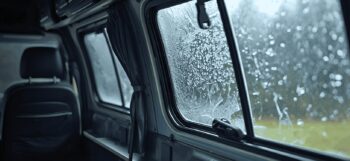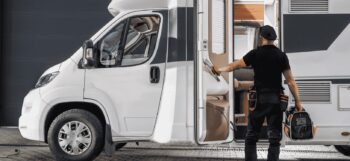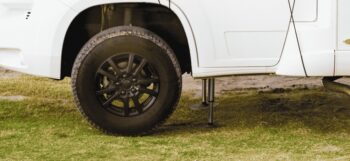Caravanning is an enjoyable and adventurous way to explore the great outdoors, but it also comes with its own set of safety considerations.
One of the most critical safety components for safe caravanning is the breakaway cable, a simple yet essential piece of equipment that plays a vital role in ensuring your caravan stays secure during towing.
In this guide, we'll cover what you need to know about breakaway cables—what they are, why they're necessary, and how to properly fit and maintain them. Whether you're new to caravanning or looking to refresh your knowledge, this guide can help you to stay safe on the road.

What is a caravan breakaway cable?
The function of a breakaway cable is pretty much as the name suggests – it is designed to apply the brakes and disconnect if the caravan becomes detached from the towing vehicle. Although such detachments are rare, their consequences can be severe, which highlights the importance of having this safety feature in place and correctly installed.
As of 2024, it remains a legal requirement in the UK for all caravans with a maximum technically permissible laden mass (MTPLM) between 750 kg and 3500 kg to be fitted with a breakaway cable. This regulation applies to all caravans, trailers, and similar vehicles manufactured after October 1, 1982.* This, and further information, can be found in NCC Caravan Towing Guide.
Breakaway cables are typically made of a thin steel cable that provides the necessary strength and durability to engage the caravan's brakes if it becomes detached from the towing vehicle. The steel cable is usually coated with plastic to protect it from corrosion and general wear and tear.
It is advisable to only use a breakaway cable manufactured to the original chassis maker’s specification and purchased from a reputable dealer.

How to fit a breakaway cable
- Route the Cable Properly: Ensure the breakaway cable is routed directly from the car through any guides on the caravan’s drawbar.
- Secure the Cable: Loop the cable through the designated hole and double it back on itself. Avoid clipping the cable directly to the attachment point, as this may lead to malfunction unless the cable is specifically designed for direct attachment, such as those equipped with a heavy-duty carabiner.
- Alternative Attachment: If there are no suitable holes or loops on the towbar, loop the cable around the neck of the towbar, underneath the coupling head, and clip it back onto itself. For detachable towballs, consult the manufacturer’s guidelines before attaching the cable.
- Follow Manufacturer's Instructions: Some breakaway cables may be designed to attach to a permanent part of the towbar, caravan, or a purpose-built attachment accessory. Always check the manufacturer's guidance before using these configurations.
- Avoid Kinks or Loops: Ensure the cable is free of any kinks or loops that could interfere with its function.
- Check Cable Length: Verify that the cable is long enough to prevent the brakes from being applied during normal towing, including when navigating corners, but short enough to avoid contact with the road or entanglement with other objects.
- Prevent Tangling: Make sure the breakaway cable is positioned so it does not touch with an electrical cable or an external stabiliser, as they could become tangled.
- Replace Damaged Cables: If the cable shows any signs of damage, even minor, it should be replaced immediately to maintain safety.
It is sensible to practice fitting the breakaway cable at least once prior to your first towing journey.

Maintaining a breakaway cable
Alongside the challenge of proper attachment of the cable to the tow car, the cable can become damaged or kinked over time, which might cause it to snap before it engages the caravan brakes in the event of an emergency.
The breakaway cable must be checked regularly for damage, preferably before each trip. This should include a thorough examination of both cable and clip, to find signs of damage, or wear and tear. Contact the manufacturer or supplier if in any doubt as to the condition of the cable or clip.
When attached, the breakaway cable should also be regularly inspected as follows:
- Make sure the cable cannot become tangled with the electricity cable, coupling head, jockey wheel, stabiliser, cycle carrier or any other piece of equipment. It should not be possible for even the slightest snag to occur
- Ensure that the cable is not so tight that it is at risk of activating the brakes while the towing vehicle is in motion and not so loose that it may drag on the ground
- Check for any signs of damage and replace as necessary
Failing to maintain the breakaway cable can also have serious implications for insurance claims.
If an investigation reveals that the breakaway cable was damaged or not properly maintained, your insurance company could reject your claim. This is because inadequate maintenance of safety equipment can be seen as negligence, which could void coverage. Even if a claim is accepted, the insurer may reduce the payout if it’s determined that the failure to maintain the breakaway cable contributed to the severity of the incident. They might argue that proper maintenance could have prevented or minimised the damage.

Tools required for replacing a breakaway cable
There are often discussions on caravanning forums about the best tools to use when replacing a breakaway cable, as the rings and clips on different models can vary significantly. While there aren’t specific tools you should use, experienced caravanners commonly recommend the following:
- A large screwdriver to pry the loop open and a pair of mole grips to close the loop on the new cable
- Heavy-duty pliers for securely closing the new ring
- A small portable engineer’s vice for holding components in place during installation
- A hacksaw to remove the loop of a particularly stubborn old cable (exercise caution when using this tool)
Regardless of the tools you choose, it's important to avoid anything that could damage the cable or interfere with its functionality. Ensure that the breakaway cable is installed correctly to maintain its effectiveness.
How to hitch up a caravan and car
- Raise the height of the jockey wheel so that the hitch is higher than that of the car towball
- Check that the towball is clean and free from grease and dirt
- Reverse the car into position
- Attach the breakaway cable
- Using the jockey wheel, lower the caravan hitch on to the towball
- Check that the green indicator is visible and give the hitch a good tug to make sure that it is fixed securely to the towball
- Engage the stabiliser
- Attach the electrics
- Release the caravan handbrake and retract the jockey wheel fully, securing it into its traveling position
- Make sure that the electrics are fully working by checking all of the rear lights on the caravan
When you arrive on site (or at home), follow the instructions above in reverse, making sure that the breakaway cable is the last thing that you do before you move the car away. That way should the caravan or trailer move unexpectedly backwards, the brakes will be activated immediately.
How to un-hitch a caravan and car
- Engage the handbrake on the car and turn off the car’s engine
- Engage the caravan’s handbrake and disengage the stabiliser if fitted
- Lower the caravan jockey wheel
- Clamp the shaft of the jockey wheel
- Chock the caravan wheels, particularly if on a slope
- Disconnect the electrical system (make sure that the cable is not left to trail
- on the ground)
- Raise the front of the caravan on the jockey wheel whilst releasing the coupling clear of the hitch ball
- Unclip the breakaway cable and stow carefully (tripping hazard)
- Drive the car away from the caravan (or MOVE the caravan away from the towball)
- Use the jockey wheel to level the caravan front to back
- Lower the corner steadies, using pads if the ground is not firm
- Remove the towing mirrors if the car is to be driven without towing
Accidents can happen
Owning a caravan gives you the wonderful freedom to get away from it all whenever and wherever you choose. Ensuring you have suitable insurance in place will mean that you can enjoy your holidays with the reassurance that protection is in place, should you need it.
As a specialist broker, we work with our insurer partners to offer policies to meet your needs, based on the information you provide - whether that's over the phone on 01480 402 460 or through our secure online insurance quote service.
For information on our feature-packed caravan insurance visit https://www.lifesure.co.uk/personal-insurance/caravan-insurance
*Data taken from https://www.westerntowing.co.uk/breakaway-cable-trailer-caravan/
Disclaimer: The sole purpose of this article is to provide guidance on the issues covered. This article is not intended to give legal advice, and, accordingly, it should not be relied upon. It should not be regarded as a comprehensive statement of the law and/or market practice in this area. We make no claims as to the completeness or accuracy of the information contained herein or in the links which were live at the date of publication. You should not act upon (or should refrain from acting upon) information in this publication without first seeking specific legal and/or specialist advice. Arthur J. Gallagher Insurance Brokers Limited trading as Lifesure accepts no liability for any inaccuracy, omission or mistake in this publication, nor will we be responsible for any loss which may be suffered as a result of any person relying on the information contained herein.
FP1287-2025











